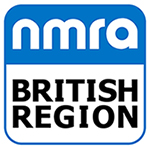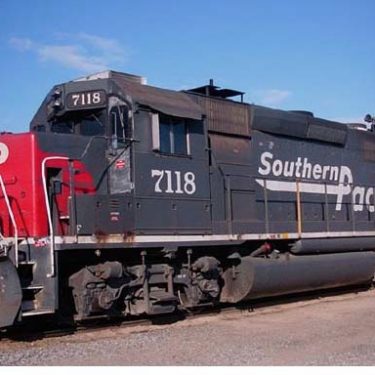By Mike Arnold; prototype photographs by the author and Tony Madieros
Previously published in Roundhouse in June 2005
Many of you may recall I wrote an article “Getting Beyond the Blue Box” for Roundhouse April 2003, describing how I detailed two RTR GP40-2 models to make them more like the prototype. In it I mentioned just how varied different phases of the prototype were and that attention to photographs was essential for any attempt at accuracy. Here I set out just what those variations are. I hope to write future articles describing other SP diesels that I have detailed and kitbashed (SD40T-2s; SD40M-2s; SD45T-2s etc). With detail parts from Details West, Detail Associates, Sunrise Enterprises and Cannon & Co, there is no excuse for not having a reasonably accurate model.
The following were released in phases over a number of years, some being re-engineered by Morrison-Knudsen from earlier models, and delivered in SP or SSW/Cotton Belt (St Louis South Western) colours:
SSW 7600-7607 GP40 Delivered 1966
(renumbered 7960-67 GP40R Rebuilt 1982)
SP 7608-7627 GP40-2 Delivered Feb-Apr 1978
SSW 7628-7657 GP40-2 Delivered Jan-Feb 1979
SP 7658-7677 GP40-2 Delivered Mar 1980
SP 7940-7959 GP40-2 Delivered Apr-May 1980
SP 7240-7247 GP40-2 Delivered Nov 1984
SSW 7248-7273 GP40-2 Delivered Oct-Nov 1984
SSW 7274-7293 GP40M-2 Delivered Nov 1990-Jan 1991
SP 7294-7299 GP40M-2 Delivered Jan-Feb 1991
SP 7100- 7138 GP40M-2 Delivered Feb-Jul 1991
The first deliveries in 1966 were the then standard 81” noses, Blomberg B trucks, chicken wire grilles (1), early dynamic brake housing (2) and ratchet brakes(3), with standard EMD jacking pads (4), roof-mounted bell, SP light array on the nose only(5) and drop steps (6). The Atlas model is very close missing only the SP light array and the later blower housing (though the two horizontal ribs on the Atlas model can be easily removed).

UP patched GP40M-2 #1490, former SP #7120 is a good illustration of the early era GP40-2, although it does not have an SP light array and its bell is below the running board, not roof mounted, and the horn has been moved to the long hood.
The Athearn model is less accurate, missing the light array, the early dynamic brake housing (was available as a Railpower part), the trucks (supplied with Blomberg Ms), blower housing and the nose which is probably the 88” version (but who notices 7”?). Other detail can be added from the spares box as required. Note there was no air conditioner unit when this firsyt serried was built, nor antenna stands which became a signature of all later SP models. 7600-7607 were rebuilt internally in 1982 and renumbered 7960-67 – the only discernable change externally seems to be the bell was relocated to below the footplate running board in front of the fuel tank.
By 1978 the 88” nose had become standard, but SP specified a whole lot more this time from the next generation:
Corrugated grilles (1); later dynamic brake housing (as supplied on Athearn model) (2); hand wheel brake (3); Blomberg M trucks (4); ditchlights (added later) (5); anti-climber (6) and the distinctive 4-hole jacking pads (7). Rooftop air conditioner and antenna stand are now standard. There will also be the standard SP light array on the short nose and rear hood too now and the rear hood end is plain with no number boards (not present on the Athearn model). The photo below depicts #7661 delivered in 1980 as delivered but for the removal of the red nose, the removal of the cab lights, and a full repaint in the post-1988 speed lettering. In this example the horn remains as at October 2002 on the cab roof. Most had been moved to the long hood by that time.

The above body style and details were applied to SP 7608-7627, SSW 7628-7657, SP 7658-7677 and SP 7940-7959.
With the delivery of SP 7240-7247 and SSW 7248-7273 a further variation was seen. In addition to all the foregoing variations, these locomotives were delivered with a slim parallel footplate with no deepening/strengthening above the truck area (1), and the latest, more angular, version of the blower housing (2), and Q-fans, as on GP60s. A photo of GP60 UP #2029 is shown to illustrate this:

They were also delivered with a quite different rear SP light array – a box-like construction on the normal plate with the lights mounted vertically.
So having got to the final phase of GP40-2 production you might think that was the end of the SP variations. It was not. They took delivery of some locomotives, classified as GP40M-2s being rebuilds of earlier models. As a consequence some of them had little consistency in body styles as they came from a variety of sources and generations of GP40.
SSW 7274-7293 and SP7294-7299 do have considerable consistency – they were similar to the first deliveries in that they had ratchet brakes, drop steps (i.e. no anti-climber), EMD jacking pads and chicken wire grilles but had the second generation dynamic brake blister, with plain long hood end and Blomberg B trucks. Again they had air conditioner and antenna stand with frame mounted bell. But it all goes to pot with SP7100-7138. Here you will need to refer to individual photos to ensure your model is correct. For example they all have chicken wire grilles and Blomberg B trucks but some have 81” and others have 88” noses and there is a mixture of early and late brake blisters and blower housings. They do tend to go hand in hand. For example 7104 has early blister and blower unit and 7105 has both later versions but by 7111 it was back to the early version. UP #1490/SP #7120 above contrasts nicely with SP #7118:

Go to http://espee.railfan.net/spgp40m-2.html and you will see what I mean!
So if you really want that SP GP40-2 to be accurate you will have some work to do. But all the parts needed for any variant should be available if you look hard enough. The final phase is the most complex to produce, as my earlier article will testify.
Finally I must give thanks to Tony Madieros, a resident of California, who gave me permission for use of his prototype photos. His work can be seen at www.rostershots.com and on the aforementioned espee railfan site.


